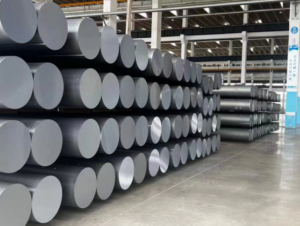In industrial production processes, high-speed steel and spring steel, as two widely used steel types, play crucial roles in modern industries. Although both possess remarkable properties, they differ significantly in material composition, performance characteristics, price, and range of applications. In this article, we will take a closer look at these differences between high-speed steel and spring steel.

5 Major Differences Between High-Speed Steel and Spring Steel:
Firstly, material composition sets them apart. The different compositions of steel materials determine their unique performance characteristics. High-speed steel, being a high-alloy steel, contains substantial amounts of tungsten, molybdenum, chromium, cobalt, and other alloying elements, granting it exceptional hardness and wear resistance. Spring steel, on the other hand, primarily comprises carbon along with a certain amount of silicon, chromium, manganese, and other alloying elements, contributing to its outstanding elastic limit and fatigue strength.
Secondly, differences emerge in their heat treatment properties. After quenching and low-temperature tempering, high-speed steel attains high hardness, retaining this even at cutting temperatures exceeding 600°C. In contrast, spring steel, through proper heat treatment, acquires remarkable elasticity and fatigue resistance.
Furthermore, their mechanical properties differ markedly. High-speed steel boasts high hardness, wear resistance, and red hardness, maintaining substantial hardness even in high-temperature environments. Conversely, spring steel excels in elasticity, yield strength, and fatigue strength, resisting failure or deformation under heavy external loads.
Additionally, there are price differences. Generally, high-speed steel tends to be more expensive than spring steel. This is attributed not only to the higher content of precious alloying elements in high-speed steel but also to its more complex processing and manufacturing requirements, leading to a higher cost.
Lastly, their applications vary widely. High-speed steel’s ability to maintain high hardness and wear resistance during high-speed cutting makes it ideal for manufacturing cutting tools such as drills, milling cutters, and broaches. Meanwhile, spring steel’s exceptional elasticity and fatigue resistance make it a preferred choice for various spring applications, including automotive suspension springs, mechanical springs, and other elastic components.
Conclusion
In conclusion, high-speed steel and spring steel, owing to their remarkable properties, find extensive use in diverse industrial sectors. However, they have distinct focuses in terms of material composition, mechanical properties, price, and application range. In practical applications, it is crucial to select the appropriate material based on specific requirements and conditions, ensuring that both steel types can fully leverage their respective capabilities.
Why Choose Sino Stainless Steel?
Thank you for reading our article and we hope it can help you to have a better understanding of the differences between high-speed steel and spring steel. If you are looking for high-speed steel and spring steel suppliers online now, we would advise you to visit Sino Special Metal for more information.
As a leading supplier of high-speed steel and spring steel from Shanghai China, Sino Special Metal offers customers high-quality 65Mn Spring Steel, 50CrV4 Spring Steel, 9260 Spring Steel, SUP9 Spring Steel, M2 High-Speed Steel, M35 High-Speed Steel, and M42 High-Speed Steel at a very competitive price.




